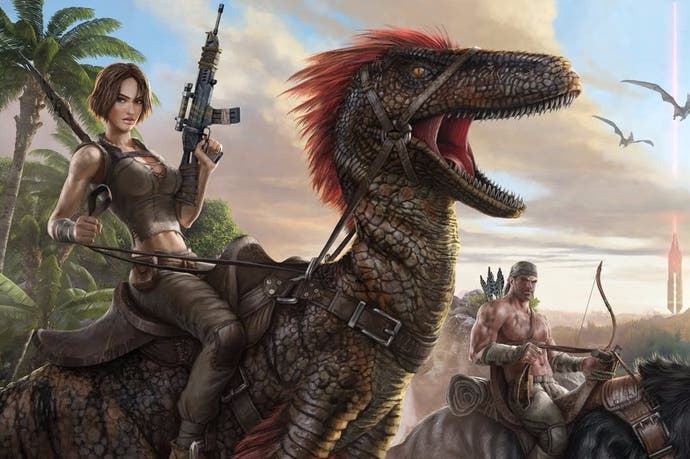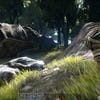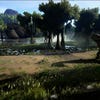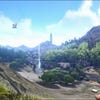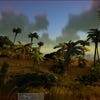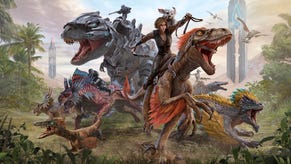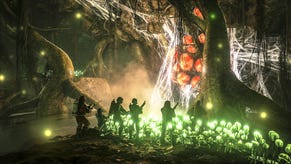Digital Foundry: Hands-on with Ark: Survival Evolved on Xbox One
It's sold over 1m copies. Is the star of Microsoft's Xbox Early Access initiative worth buying now?
Ark: Survival Evolved - in its current, preview state - is best described as something of a technological work-in-progress in its Xbox One incarnation. By every measurable criteria Digital Foundry can attach to the game, it can often border on the disastrous. And yet, even in its early access form, Studio Wildcard has managed to shift over 1m copies, building a dedicated fanbase on both console and PC. Put simply, in this preview form, it's a triumph of concept over execution. Already a 'monster' hit, gamers have invested in the title's early access status and one of its key attractions is that users feel as though they're involved in the title's ongoing development.
The basic idea behind Ark is innovative and enticing: hunt dinosaurs, build communities, and explore a tropical paradise filled with prehistoric flora and fauna. The game's island provides a massive 35 square kilometre open world to explore, along with a varied range of locations - such as sandy beaches, mangrove swamps and mountainous valleys, backed by a large selection of prehistoric wildlife freely roaming the landscape. Environments appear sufficiently detailed, though often rather last-gen in nature. Unreal Engine 4 is utilised for this project using the tech's physically-based lighting systems, but there's the sense that game isn't fully exercising the technology - materials such as wood, stone and cloth appear rather artificial, impacting the title's immersive qualities.
Despite this, the scope of the overall island still stands out, with distant forests, valleys, and mountainous peaks featuring a fair share of trees and foliage. Locations feature an impressive sense of scale, enhanced by the uneven levels of terrain across the island. Draw distances can't compare with titles such as Just Cause 3 or Assassin's Creed Syndicate though, and it's clear that smaller environmental objects and the game's wildlife are culled at a much closer range. Pop-in is noticeable here, with scenery initially appearing via a dithered fade, before hard switches are made to higher quality models as the camera gets closer.
Alternative analysis: Ark: Survival Evolved Xbox One launch code analysis and commentary
Resource-gathering and crafting forms a fundamental part of Ark, and as a result environments feature a limited amount of destructibility in the form of man-made structures that can be built up and destroyed, alongside greenery to plunder. For example, trees can be uprooted, although when felled they disappear into thin air rather than fall onto the ground and leaving debris behind.
Really, the main hook to the game is the ability to hunt and tame Dinosaurs and other extinct creatures, and this is one area where the developer has clearly focused its resources. There are over 60 species found in the game, with some featuring feathers in line with recent thinking on how dinosaurs actually looked, while others like the T-Rex seem to be inspired more from designs created for Jurassic Park. Geometry complexity appears to be a step back from the latest triple-A titles, but we still see a fair amount of detail on these creatures, and animations appear reasonably fluid. However, as with many other elements in the game, the handling of materials can look a touch primitive: skin textures appear plastic-like, and there's a lack of realism across the way surfaces behave under different lighting conditions. That's surprising, bearing in mind UE4's state-of-the-art rendering features.
Technologically speaking, there is a long, long way to go before this game reaches the kind of standard we expect from a major release. From a resolution perspective, we're looking at a game currently featuring a sub-720p resolution (1088x612 or somewhere in the region), which is a first for the current console generation and obviously something that needs to be improved. High contrast scenes suffer the most, but when switching to locations set in lower light conditions, the presentation does appear slightly smoother. Regardless, it's not an ideal situation, with a lot of distracting pixel-crawl attributable primarily to the lack of resolution.
Performance is also a big problem in both of the work-in-progress builds we've tested. The initial release failed to move beyond 30fps in our test clips, often lurching way below the desired target. Ark is often plagued with momentary stutter that can range from 100ms all the way up to 500ms - a split-second, intrusive freeze-frame effect. On top of that, the developers are running with a completely unlocked frame-rate with v-sync disabled, meaning that screen-tear is a constant companion throughout the adventure. A couple of days ago, the developers updated the game with bug fixes, more content and promises of improved performance and fewer stalls. There are boosts in both areas, but it's still in need of serious work in achieving a consistent level of performance throughout the game. The game is crying out for a 30fps cap with an adaptive v-sync solution. Romps through swampland on both builds can see frame-rate dip well below 20fps, illustrating just how much of a challenge the developers face in getting Ark: Survival Evolved into shape.
Of course, we are looking at an early access release here and not finished retail code - and that means various bugs and glitches are to be expected, and some more game-breaking than others. However, the asking price for the current version of the game weighs in at £28/$35 - presumably a fair amount lower than the final release, but still a significant amount of money to front up bearing in mind the quality of the experience on offer. However, users will get regular updates, and presumably pay less than those who buy into the game once it is complete.
And maybe the obviously work-in-progress nature of the game is part of its attraction: Ark is offering up the chance to check out - and perhaps even participate in - the ongoing development of a title with a highly exciting premise. The optimisation challenge facing the developers here is immense though, and the technological issues surrounding the title are far from trivial based on both of our rounds of testing. Whether a stable, enjoyable experience can be delivered remains to be seen, but with gameplay concepts and ideas as strong as these, we certainly hope so.
